Age of Jackson
Farming
Many Tennessee families relied on farming for all or most of their livelihood during this time. Tennessee farmers produced a variety of crops including corn, wheat, tobacco, and cotton.
Vegetable gardens were also common. The state’s farmers were renowned for their fine livestock. Farmers raised pigs, horses, mules, and cows.
Owning land was important to farmers. This period offered farmers the opportunity to own their own land. It was possible for many farmers who started out renting land to eventually buy their own property.
National problems with the banking and currency systems hurt farmers. It was difficult for them to get loans from banks to buy property or supplies.
In response, farmers, shopkeepers, and crop merchants developed their own informal systems for credit. For example, a farmer might sign a contract agreeing to guarantee that a friend would pay back a loan to another person. If the friend did not pay the money owed, the farmer became responsible for the debt. This informal credit system caused a lot of Tennesseans to get into financial trouble.
Farms in East, Middle, and West Tennessee reflected the different types of land and communities in each region. East Tennessee farms tended to be relatively small. Farmers grew a lot of food crops and raised livestock. Only one out of every ten farmers in this region owned any slaves. Those who did usually had only a few slaves. However, this region seems to have had the largest number of white farm workers who did not own their own land.
Middle Tennessee farms tended to be medium-sized, though there were some large plantations. About one out of every three farm families owned slaves in this area. In some cases farners without slaves would pay a slave owner a fee so he could use his slave to help with harvest. This region also produced a lot of foodstuffs for the market.
Read about one of the largest plantations in Middle Tennessee, Wessyngton.
Read about one of the largest plantations in Middle Tennessee, Wessyngton.
The Chickasaws controlled West Tennessee until the early 1800s. Settlers were not legally allowed buy land and establish farms there until after 1819. This means that West Tennessee grew from a frontier area to a region with many large farms, towns, and the city of Memphis during this period.
Many more people owned slaves in West Tennessee than any other area of the state. Six out of every ten farmers in this area owned slaves. West Tennessee had farms of various sizes and produced a variety of crops and livestock. But, more than any other Tennessee region, it had large cotton plantations with many slaves.
One question that has puzzled historians about farmers in this time is: Did farmers produce agricultural products to satisfy their families’ basic needs or to sell goods to others for money?
The answer seems to be both. Many Tennessee farmers, especially those who owned their own land, produced a lot more food than their families and/or slaves needed each year. Tennessee farmers sold food to their neighbors and local storekeepers. They also sold crops and livestock like pigs to other states. Some farmers also raised cash crops like tobacco and cotton that were sold on the world markets to other countries.
Picture Credits:
- Painting of a rural homestead along a dirt road by W. A. Prichard. An African American man is accompanied by two dogs and is shown riding a mule as he passes the log cabin. A rail fence is also shown along with mules and a shed in the background. Tennessee State Museum Collection, 2007.147
- Drawing showing slaves picking cotton. Tennessee State Library and Archives
- Drawing of a cotton plantation. This drawing was included in the work The History of Slavery and the Slave Trade, Ancient and Modern by William Blake in 1859. It shows several slaves picking, loading, and carrying cotton while an overseer watches. Another slave is shown driving a team of oxen and a cart. New York Public Library
- Print entitled, “The Plough.” It shows a man directing a young boy about guiding a plow. Tennessee State Museum Collection, 2005.230.62
- Drawing entitled, “Weighing bales of cotton.” This drawing was published in 1882 in the work America Revisited: From the bay of New York to the Gulf of Mexico by George Sala. It shows men weighing a bale of cotton with a large scale. Other men are shown hauling away another bale. New York Public Library
Age of Jackson >> Tennessee's People >> How They Worked >> Farming
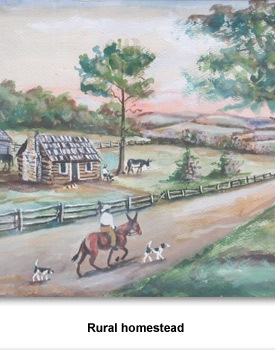
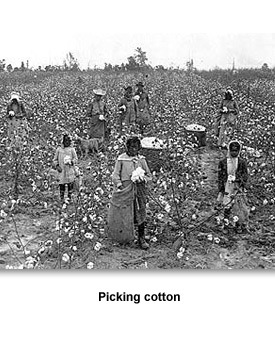
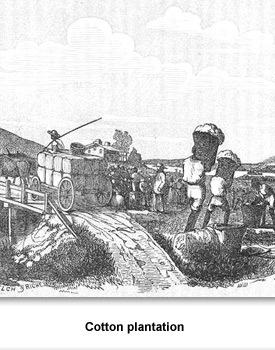
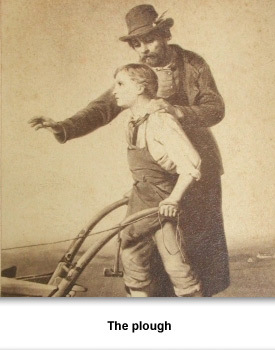
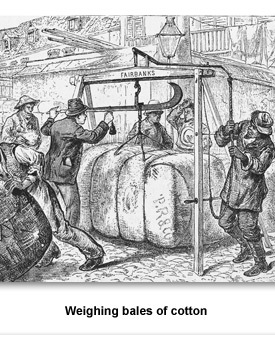
 Sponsored by: National Endowment for the Humanities
Sponsored by: National Endowment for the Humanities